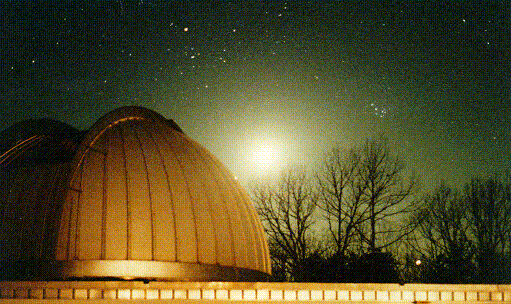
The telescope at the Three College Observatory is a Cassegrain reflecting telescope. The mirror diameter is 0.81 meters (32 inches). This characteristic of a telescope is perhaps the most important factor in determining the telescope’s effectiveness as a research instrument since it determines the amount of light it can collect, and hence the effectiveness of the telescope in detecting very dim or very distant objects.
The telescope at the Three College Observatory can collect approximately 26,000 times as much light as the human eye.
The telescope is the largest telescope in North Carolina, and one of the largest in the southeastern United States. The only larger telescopes at dark sky locations include the 41-inch Fan Mountain telescope operated by the University of Virginia, and the 36-inch telescope operated by the University of Florida.
The f/13.5 telescope was constructed in 1979 by Sigma Research, Inc., of Richland, WA and installed at the Three College Observatory in May 1981. The fork-mounted equatorial design uses a friction drive for both right ascension and declination axes, and is capable of tracking along both axes. The telescope utilizes a Cer-Vit primary mirror and Ritchey-Chretien optics. The usable photographic field size is 3.75 inches in diameter at a plate scale of 18.8 arc seconds/mm. The telescope weighs 9000 lbs. and is mounted on a 7 x 8 x 10 foot concrete pier weighing 50 tons.
The telescope is equipped with an f/10 6-inch refractive finder telescope (with a 1.3 degree field) designed and built by Duncan Davidson of Seattle, Washington. Instrumentation for the telescope includes a photographic camera utilizing 4 x 5 inch glass plates, an archaic digitized ISIT low light level video camera, an echelle spectrograph, and a state-of-the-art CCD Video Camera.
The telescope’s motion and positioning is controlled by the PC-TCS/DCS DC Servo Motor Telescope Control System from COMSOFT, 1552 West Chapala Drive, Tucson, Arizona 85704 (520) 360-2078
Images of the observatory building and telescope may be found in the following:
The observatory photo that decorates this page was taken by Dr. Jeffrey Knerr.